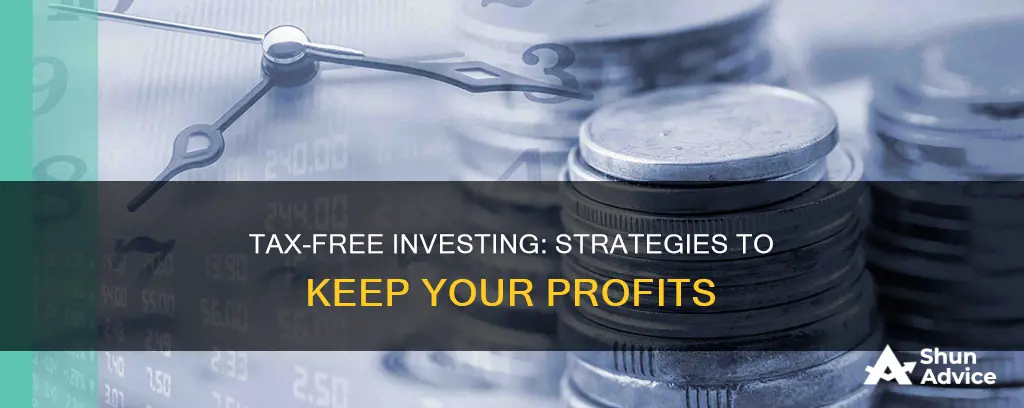
How to Invest and Avoid Paying Tax
There are several ways to invest your money without paying tax on your gains. However, it's important to note that it's almost impossible to avoid paying tax altogether. Instead, the aim is to minimise the amount of tax you pay. Here are some of the best ways to keep taxes low on your investment income.
Tax-efficient investing
Tax-efficient investing involves choosing the right investments and the right accounts to hold those investments. There are two main types of investment accounts: taxable accounts and tax-advantaged accounts. Taxable accounts, such as brokerage accounts, don't offer any tax benefits, but they do offer more flexibility than tax-advantaged accounts. Tax-advantaged accounts, such as IRAs and 401(k)s, provide tax benefits but have more restrictions.
Investments that are tax-efficient
Some investments are more tax-efficient than others. For example, municipal bonds are very tax-efficient because the interest income isn't taxable at the federal level and is often tax-exempt at the state and local level. Treasury bonds and Series I bonds are also tax-efficient because they're exempt from state and local income taxes.
Tax-advantaged accounts
Tax-advantaged accounts like IRAs and 401(k)s have annual contribution limits. In 2024, you can contribute up to $7,000 to your IRAs, or $8,000 if you're age 50 or older. With 401(k)s, you can contribute up to $23,000 in 2024, or $30,500 with the catch-up contribution.
Other ways to minimise taxes
There are also other ways to minimise the amount of tax you pay on your investments. For example, if you hold an investment for over a year, you'll pay the more favourable long-term capital gains rate. You can also use tax loss harvesting to reduce or eliminate your taxable capital gains.
| Characteristics | Values |
|---|---|
| Investment type | Municipal bonds |
| Investment type | Long-term capital gains |
| Investment type | Retirement accounts |
| Investment type | Health savings accounts |
| Investment type | Exchange-traded funds |
| Investment type | Life insurance |
| Investment type | 529 college savings plans |
| Investment type | Real estate |
What You'll Learn

Invest in municipal bonds
Municipal bonds, or muni bonds, are debt securities issued by local governments to fund projects such as building schools, hospitals, highways, and sewer systems. They are generally considered safe investments, as there is a very low risk of default. The interest income from these bonds is usually exempt from federal taxes, and may also be exempt from state and local taxes if you live in the state where the bond is issued.
There are two main types of municipal bonds: general obligation bonds and revenue bonds. General obligation bonds are issued by governmental entities and are backed by the "full faith and credit" of the issuer, meaning they have the power to tax residents to pay bondholders. Revenue bonds, on the other hand, are backed by revenues from a specific project or source, such as highway tolls or lease fees.
When investing in municipal bonds, it is important to consider the tax implications, as there may be federal, state, and local tax consequences when buying, selling, or owning the bond. Additionally, a portion of the income received may be subject to the federal alternative minimum tax. It is always recommended to consult a tax professional before investing.
Investing: Is It Right for Your Money?
You may want to see also

Take long-term capital gains
Taking long-term capital gains is one of the most effective ways to reduce or avoid capital gains tax. Long-term capital gains are derived from assets held for more than a year before being sold. The longer holding period results in a more favourable tax rate compared to short-term capital gains, which are taxed as ordinary income.
Invest for the Long Term
By holding your investments for over a year, you can benefit from the lower long-term capital gains tax rates. For example, in 2024, if your taxable income is below $47,025 as a single filer or $94,050 for married couples filing jointly, your long-term capital gains tax rate will be 0%. This is a significant saving compared to short-term capital gains, which are taxed at the same rate as ordinary income, which can be as high as 37%.
Take Advantage of Tax-Deferred Retirement Plans
Investing through tax-deferred retirement plans such as 401(k), 403(b), or individual retirement accounts (IRAs) allows your money to grow without immediate taxes. You can buy and sell investments within these accounts without triggering capital gains tax. Withdrawals from traditional retirement accounts will be taxed as ordinary income, but you may be in a lower tax bracket by the time you withdraw the money. With Roth IRA accounts, if you follow the rules, the money you withdraw will be tax-free.
Pick Your Cost Basis
When selling stocks, you can choose your cost basis for the shares you sell. By selecting specific shares, you may be able to avoid capital gains taxes by selling shares that are at a loss or have lower gains, even if your overall position in that investment has made money.
Watch Your Holding Periods
Be mindful of the one-year threshold for long-term capital gains. If you're selling a security that you bought about a year ago, it might be worth waiting a few more days or weeks to qualify for the long-term capital gains tax rate, assuming the investment's price remains relatively stable.
Offset Capital Gains with Capital Losses
If you experience an investment loss, you can use it to offset the tax on your gains from other investments. Capital losses can be used to reduce your capital gains tax liability and, if your capital losses exceed your capital gains, you can use up to $3,000 of those losses to offset ordinary income for the year. Any remaining losses can be carried forward to future tax years.
By implementing these strategies, you can legally minimise or even eliminate your capital gains tax liability, allowing you to retain more of your investment profits.
Ratios Reveal: Investing Insights
You may want to see also

Max out retirement accounts
Retirement accounts are a great way to invest your money without paying tax. Here are some ways to maximise your tax-free retirement savings:
- Contribute to a workplace retirement account: If your employer offers a retirement plan, such as a 401(k) or 403(b), find out if they will match your contributions up to a certain amount each year. This is sometimes known as a 'vesting' period. If so, contribute at least enough to get the full match. This is essentially free money!
- Contribute to a Health Savings Account (HSA): If you are enrolled in an HSA-eligible health plan, consider using an HSA to save for healthcare costs in retirement. You can get three tax benefits from HSA contributions: an initial tax deduction, tax-free potential earnings, and tax-free withdrawals when you use the money for qualified medical expenses.
- Maximise your workplace savings plan: If you have already contributed up to your employer's match, you may want to save more for retirement. Consider maxing out your 401(k) contributions.
- Contribute to an Individual Retirement Account (IRA): IRAs are not connected to an employer, so you can contribute to one of these in addition to your workplace plan. There are several types of IRA, including traditional IRAs and Roth IRAs, each with different benefits and requirements.
- Add after-tax money to your 401(k): Your employer might allow you to add after-tax money to your 401(k), enabling you to contribute beyond the individual limit.
- Invest in brokerage accounts: Once you have maximised your contributions to tax-advantaged retirement accounts, you can continue saving and investing in regular brokerage accounts. The tax advantages won't be the same, but you will still benefit from the potential for long-term growth and flexible access to your money.
Saudi Women's Rights: Investors' Dilemma
You may want to see also

Use a health savings account
A health savings account (HSA) is a great way to save for future medical expenses while reducing your taxable income. HSAs offer a triple tax benefit. Firstly, your contributions are made from your pre-tax paycheck, or you can deduct them from your taxes if you contribute from your after-tax income. Secondly, the money in your account grows on a tax-deferred basis. And finally, when you withdraw the money to pay for qualified medical expenses, the distribution is 100% tax-free.
To be eligible for an HSA, you must be on a high-deductible health insurance plan. In 2024, you can contribute up to $4,150 for individual coverage or $8,300 for family coverage. Some employers may also make contributions to your HSA. You can invest your HSA funds in a variety of ways, including mutual funds and other investments.
It's important to note that if you use your HSA funds for non-medical expenses before you turn 65, you will have to pay taxes and a 20% penalty on those withdrawals. However, after you turn 65, you can use your HSA funds for non-medical expenses and only pay regular income tax on the withdrawals, similar to withdrawals from 401(k)s and IRAs.
By investing your HSA funds, you can take advantage of the tax benefits and potentially grow your savings faster. This can be a great way to prepare for future health care costs and ensure you have the funds to cover any necessary expenses.
Reality TV: Poor People's Escape
You may want to see also

Claim tax credits
Tax credits are a dollar-for-dollar amount that taxpayers can claim on their tax returns to reduce the income tax they owe. There are two types of tax credits: refundable and nonrefundable. If a taxpayer's tax bill is less than the amount of a refundable credit, they can receive the difference as a refund. However, for nonrefundable tax credits, once a taxpayer's liability is zero, they will not receive any leftover amount as a refund.
- Earned Income Tax Credit (EITC): This is a refundable credit for moderate- and low-income taxpayers. To claim the EITC, you must qualify and file a federal tax return. The EITC can be claimed by individuals with qualifying children or relatives, and those without a qualifying child.
- Child Tax Credit and Child and Dependent Care Tax Credit: The Child Tax Credit is nonrefundable and reduces the taxpayer's tax liability. To qualify, the child must be a U.S. citizen under 17 with a Social Security number and be claimed as a dependent on the taxpayer's tax return. The Child and Dependent Care Credit can be claimed by taxpayers who paid for childcare or dependent care for their child, spouse, or dependent.
- American Opportunity Tax Credit: This credit is for qualified education expenses for the first four years of higher education. It is partially refundable, and taxpayers can receive a maximum annual credit of $2,500 per eligible student.
- Education Credit: If you pay for higher education, you may qualify for an education credit.
- Saver's Credit: If you put money into retirement savings, you may be eligible for the saver's credit.
- Premium Tax Credit: If you buy health insurance in the marketplace, you may be able to claim the Premium Tax Credit.
- Credits for Clean Vehicles and Clean Home Energy: Individuals who invest in clean (electric or hybrid) vehicles or make home energy improvements may be eligible for credits.
- Credits for Other Personal Taxes: There are also less common credits available for individuals who paid taxes overseas, overpaid Social Security or RRTA tax, paid alternative minimum tax in prior years, or paid tax on undistributed capital gains.
Equity Investment: Why Take the Risk?
You may want to see also
Frequently asked questions
There are a few ways to avoid paying taxes on your investments. One way is to invest in a tax-advantaged retirement account, such as a Roth IRA or 401(k), which offers tax-free growth on your investments. Another way is to hold your investments for the long term, as long-term capital gains are taxed at a lower rate than short-term gains. Additionally, you can invest in municipal bonds, which are generally exempt from federal, state, and local taxes.
Tax-efficient investing can help you maximize your returns and minimize the amount of taxes you pay. By reducing the amount of taxes you pay, you can keep more of your money and have more to spend in retirement. Tax-efficient investing can also provide more flexibility with your investments, as you can withdraw your money at any time without incurring taxes or penalties.
Some tax-efficient investments include municipal bonds, Roth IRAs, 401(k)s, health savings accounts (HSAs), and exchange-traded funds (ETFs). These investments offer tax advantages such as tax-free growth, tax-deductible contributions, and lower tax rates on long-term capital gains.







